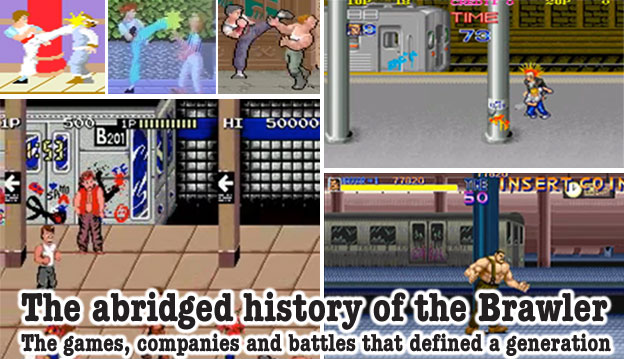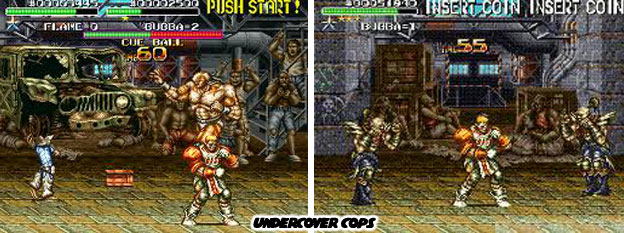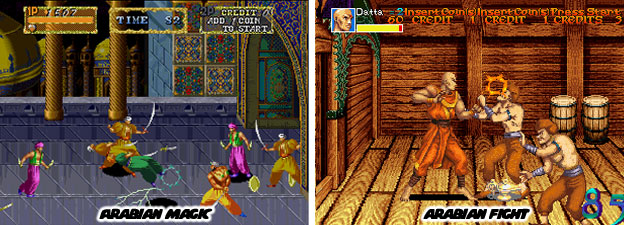
Konami made sure that 1992 got off to a good start with the X-Men game, their next title was also a licensed brawler. Bucky O'Hare was a popular animated series based on an independent comic. It featuring a crew of anthropomorphic alien / animals that were fighting for freedom out in the cosmos.
The game was lighthearted and followed the visual style of the cartoon, going so far as to include sound bytes from the voice actors from the TV series. The game was not very difficult for seasoned players, it was not meant to introduce new gameplay elements. The game was important however because it was designed for a new generation of gamer. The bright colors, smooth animation and clean level design could be seen as an attempt to make a kid-friendly brawler. Those players would be interested in trying out the other titles from Konami and help keep the industry going.

One of the other titles that could be described as player-friendly was Silent Dragon by Taito. It was a very formulaic 4-player brawler, capitalizing on the western fascination with ninjas, fights and random monsters. The large colorful sprites were very animated and the game never felt heavy-handed.
The game was about as simple and straightforward as a brawler could get. Taito did not develop a game as much as they picked characters, designs and themes from other studios and put them in a game. Taito had not done players any favors but was helping move the industry forward with a cross pollination of elements.
Irem did a better job with the brawler they introduced that year. Undercover Cops returned to the Japanese roots of pandering to the west while making some interesting design choices. In the far future (2015) crime had run amok. Different gangs, some bordering on cults, ruled the streets. Officials formed a team of "City Sweepers" to clear out the thugs, mutants and creeps. I think there was something lost in translation when the characters were created. The three playable characters were Claude the ex-karate master, Bubba the ex-pro football player and Flame ex-female vigilante. I always laughed wondering how somebody could be an ex-karate master, as if they got hit too many times in the head and forgot how to perform karate. Or Flame, who was a rip-off of Blaze from Streets of Rage. Flame was an ex-female vigilante... I thought Poison and Roxy from Final Fight were the only transgender brawlers… but I digress.
The game was unique in that it allowed all three players to choose the same character rather than being forced to use their partners. Characters also had special attacks and techniques that allowed them to knock leaping opponents out of the sky or strike opponents on the other side of the screen. The best brawling experiences were built around characters that weren't slightly better than opponents but had access to techniques and abilities that made fighting fun rather than redundant. The hard hitting heroes that young boys idolized were and should always be head and shoulders above the lowest goon and almost on par with boss characters.

This game was notable also in that the visuals were dark and detailed. Those were the trademarks of other Irem titles. Some of the artists that worked on Undercover Cops would be the same people drawing the insanely detailed pieces for GunForce II, In the Hunt and the iconic Metal Slug series.
The last two great titles worth mentioning were both set in the Middle East. Sega returned with their System 32 engine and scalable sprites with Arabian Fight. The game featured some of the largest sprites ever in any brawling game. The engine would pan out to show more of the stage as players moved further and further away from each other. It was not until this game was released that the limitations of sprite-based combat in pseudo 3D environments became visible.
A sprite is an animated 2D image, it can be presented to gamers with a sense of weight and depth if artists and programmers remember to draw in shadows and highlights as well. The other visual elements in the game like the perspective and angles used to draw levels could help players visualize the sprite as moving in three-dimensions. Arabian Fight constantly scaled in and out, far more often than in the Spider-Man game. As the camera kept changing distance it became obvious to players that they were looking at 2D objects. The sprites appeared like animated hieroglyphs, flat characters from the walls of some ancient Egyptian tomb. Now if Sega had meant for the entire story to play out on the walls of a temple, or on the pages of a book, then the effect would have been revolutionary. Unfortunately the game was supposed to take place in 3D space and as often as the sprites scaled the game suffered. Players were not fans of the paper-thin sprites. They seemed to ignore the magic system from the game and even the exotic locations featured within as well. The game was Sega's second sleeper in a row. They would shy away from further arcade brawlers and concentrate instead on the home series with Streets of Rage sequels.
Despite the lackluster showing from Arabian Fight the genre was still in need new places to visit and explore. The use of exotic places and legendary characters to play as would help expand the universe. Taito answered the call through Arabian Magic. Like Arabian Fight it too featured multiple characters to play as and a magic system. The locations were even similar, including elaborate palaces, mysterious dungeons, flying carpets and pirate ships. The similarities ended there. Taito used a fixed camera that highlighted the small but detailed figures on elaborate backgrounds.

The game worked because it pandered to the fantastic legends that most gamers in the west had grown up with. Not necessarily from reading the adventures of Sinbad or the 1001 Arabian Nights of Scheherazade but instead from consuming those legends in moves. That was certainly the case for my brothers and I as we were raised on classics like the Thief of Bagdad and The Golden Voyage of Sinbad.
Many a Sunday afternoon was spent watching those movies on TV. Wondering how the Kali statue was brought to life or how the other special effects were accomplished before the aid of computers. The legends of Sinbad were always more appealing to me as a youngster. It was always easier to identify with a dark-skinned hero (even if it was only a tan) than the pasty white guys playing King Arthur and Robin Hood. Not to mention the love interest, a chesty Caroline Monro that sent my adolescent head spinning. Guinevere and Maid Marian could stay locked up in a tower for all I cared! Anyhow, my brothers and I loved the magic, fantasy and worlds that those movies exposed us to and we were eager to see how they would be adapted in a game. Prince of Persia, released by Broderbund gave us taste of that world in 1989. Still we longed for something a bit more epic.
Arabian Magic was the title we were hoping to see in arcades much earlier The sprites and opponents were a fraction of the size of those in Arabian Fight but the game was exponentially greater. The archetypes fought in exotic palaces, decorated in elaborate tiles and ornate rugs, many of them set with traps and pitfalls. Towering minarets of gold dotted the background. Players battled guards, assassins, skeleton warriors, sorcerers and magical creatures. The boss characters could be captured and placed in lamps if they were defeated. The magic system in the game was unlike those from other titles. Players had a finite number of djinn (genies) that they could capture and use. Each spell had its own effect and range. Once used the spirit was gone forever. This management of items was unique among all the brawlers. The locations and heroes from myth, including Sinbad, were icing on the cake. The game was imperfect for its minimal animations. Had a studio like Capcom developed this game then it would have easily made the list of the top 10 greatest brawlers of all-time. 1992 was a very quiet year for brawlers compared to the previous year. The handful of games released did have their own charm but would be forgotten as the industry pushed forward. As always if you enjoyed this blog and would like to sponsor me please visit my Patreon page and consider donating each month, even as little as $1 would help make better blogs and even podcasts!

No comments:
Post a Comment